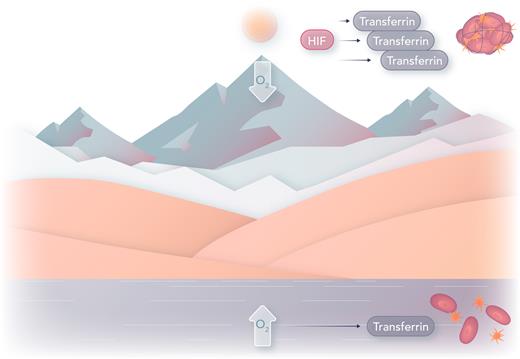In this issue of Blood, Li et al1 demonstrate that hypoxic conditions in mice or in humans living at high elevation led to increased transferrin expression and a risk of thrombosis.
Globally, 500.3 million people live above 1500 m, 81.6 million above 2500 m, and 14.4 million above 3500 m elevation.2 An additional 100 million people who live at a low altitude visit mountainous areas above 2500 m annually. People whose ancestors have lived at elevation have evolved adaptations, including increased respiratory rate and lung function in the Himalayas and increased red blood cell production in the Andes. Those whose ancestors are from lower elevations are at risk of altitude sickness above 2500 m, which can cause life-threatening cerebral and pulmonary edema and thromboembolism. Low oxygen levels activate hypoxia-inducible factor (HIF), a transcription factor for many genes including those that induce red blood cell production, such as the plasma iron transport protein transferrin.3 Transferrin transports iron in blood and is normally bound to fibrinogen. The authors had previously shown that increased transferrin is prothrombotic, where increased free transferrin not bound to fibrinogen interacts with thrombin, factor XIIa (FXIIa), and antithrombin.4 In this article, the authors extend their previous research using both humans, living long term at different altitudes, and mouse models to explain how hypoxia triggers thrombosis through increased circulating free transferrin (see figure).
At low elevations, transferrin is produced at levels that do not induce thrombi. At higher elevations, low oxygen levels induce HIF, increasing transferrin expression. The increased transferrin in the blood is procoagulant, contributing to thromboembolism seen in altitude sickness.
At low elevations, transferrin is produced at levels that do not induce thrombi. At higher elevations, low oxygen levels induce HIF, increasing transferrin expression. The increased transferrin in the blood is procoagulant, contributing to thromboembolism seen in altitude sickness.
This article provides 3 major advancements in the field of understanding altitude-induced thromboembolism. First, they show a correlation between elevated transferrin and clotting factor activity in humans living at higher altitudes. Second, mice kept in hypoxic conditions similar to those experienced by humans living at altitude, developed elevated transferrin and coronary thrombi. Finally, the impact of hypoxia on thrombosis in mice was ameliorated using transferrin-specific antibodies, inhibitory peptides, and knockdown using a virus.
Plasma transferrin is normally bound in a 4:1 stoichiometry with fibrinogen, leaving very little free transferrin in circulation. At an elevation or under hypoxia, activation HIF-1α increases transferrin expression and could be blocked by HIF-1α inhibitors. Transferrin levels then exceed fibrinogen, and the excess free transferrin creates a procoagulant environment by enhancing thrombin and FXIIa while reducing antithrombin activities. Mice kept in hypoxic conditions showed increased thrombosis in carotid arteries and deep veins, which could be reversed with transferrin antibodies and peptides that block transferrin binding to thrombin and FXIIa. Viral knockdown of transferrin in mice also created resistance to these ischemic events triggered by hypoxia. These results provide a mechanism by which transferrin directly contributes to altitude-induced thromboembolism and could lead to novel therapies to treat hypoxia. One limitation of the study was that it was only performed in humans adapted to living in the Himalayas. It would be interesting to see if humans native to the Ethiopian highlands or Andes have similar adaptations, as there are differences between high-elevation adaptations in these populations. The role of transferrin in acclimation to elevation in people who live at lower altitudes would also be important to determine in treating altitude sickness.
This research should have applications to other diseases in which hypoxia or low iron levels trigger increased expression of transferrin leading to the risk of thrombosis.5,6 Patients with sepsis have altered iron metabolism, hypoxia, and thrombi formation, and transferrin could play a role in the disease progression.7 Patients with COVID-19 can have altered transferrin levels and increased thrombosis.8,9 Finally, women who are on oral contraceptives often have low iron levels and elevated transferrin, putting them at risk of thrombosis.10 In summary, this is an important discovery explaining how hypoxia can trigger thromboembolism and will have an impact on many other disciplines.
Conflict-of-interest disclosure: The author declares no competing financial interests.


